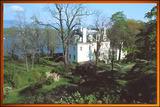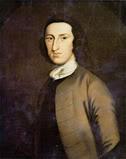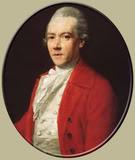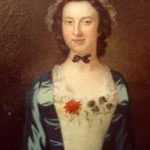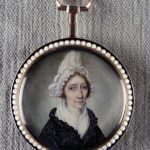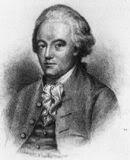Wife of Patriot Robert R. Livingston Jr.
Image: The Livingston Clermont Estate
Clermont was the Hudson River home of the prominent Livingston family of New York for more than 230 years. Because of the family’s prominent role in support of independence, Clermont was burned by British troops during a foray up the Hudson River in 1777.
Mary Stevens was the daughter of John Stevens and Elizabeth Alexander Stevens, and the granddaughter of New York lawyer and statesman, James Alexander. Mary’s father was a large landowner in the New Jersey counties of Hunterdon, Union, and Somerset, and he owned a copper mine at Rocky Hill. He was a prominent politician from New Jersey, who served as a delegate to the Continental Congress in 1783. Mary’s brother, John Stevens III, was a lawyer and inventor.
Robert R. Livingston Jr. was born in the city of New York on November 27, 1746, the eldest son of Judge Robert Livingston and Margaret Beekman Livingston. Robert Jr. had nine brothers and sisters, all of whom wed and made their homes on the Hudson River near the family estate of Clermont Manor. His great-grandfather came to America in the 1670s with little, but through hard work and a fortuitous marriage soon began building a vast empire. Real estate holdings of the influential and politically active Livingston clan eventually totaled nearly 1 million acres.
Robert was educated by the best teachers of the period, and afterwards at King’s College (now Columbia University), where he graduated in 1764, at the age of eighteen. He studied law under William Smith, the historian of New York, and afterwards in the office of his relative, William Livingston, the distinguished, governor of New Jersey.
Mary Stevens married Robert R. Livingston Jr. on the October 9, 1770. He built a home for himself and his wife just south of Clermont, called Belvedere, which was burned to the ground along with Clermont in 1777 by the British Army. In 1794, he built a new home called New Clermont, which was subsequently renamed Arryl House (a phonetic spelling of his initials, RRL) which was deemed “the most commodious home in America,” and contained a library of four thousand volumes.
In October 1773, Robert was admitted to the bar, and worked hard, becoming very eminent in his profession, and for a short time was in partnership with his friend, John Jay. Soon after this he was appointed recorder of his native city, and was an early opponent of British oppression, taking an active role in politics. In this situation the Revolution found him, so that both father and son relinquished at the same time important judicial stations to take part with their fellow-patriots in the liberation of their country.
As a member of the New York Provincial Convention of 1775, and a month later, of the Second Continental Congress, Livingston began a steady movement toward supporting American independence, but maintained an equally steady resistance to letting radicals control the Revolution in New York.
The delegates from the colony of New York to the Continental Congress, which met in Philadelphia in May 1775, were John Jay, John Alsop, James Duane, Philip Schuyler, George Clinton, Lewis Morris, and Robert R. Livingston Jr., who took a leading part in the debates of the Congress. He was on the committee to prepare and report a plan for the confederation of the colonies.
Robert was a member of the Committee of Five responsible for drafting the Declaration of Independence, along with Roger Sherman, Benjamin Franklin, John Adams, and Thomas Jefferson, but he was recalled by his state, and did not sign the document. His appointment was seemingly a political maneuver designed to encourage the equivocating province of New York into a firm commitment to independence.
After the adoption of the Declaration of Independence, the colony of New York became a State, and Robert R. Livingston Jr. was placed on the committee, with John Jay, Gouverneur Morris, Charles De Witt that drafted the New York Constitution in 1777. He was also a member of a group composed of the governor, the chancellor, and judges of the Supreme Court, which sat to revise all bills about to be passed into law by the Legislature.
In 1779, Livingston resumed his seat in the Continental Congress, and soon became part of the nationalist group, which included Robert Morris, Benjamin Franklin, and, later, James Madison and Alexander Hamilton. Upon the creation of the office by Congress, Livingston was appointed the first Minister of Foreign Affairs (Secretary of State) in August 1781. During his 2 years of service as secretary he did all he could to strengthen America’s alliance with France.
He resigned that post in 1783 to accept the appointment of Chancellor of the State of New York, the first person who had ever held that office. It was the highest legal distinction in the State, and he served in that office from 1777 to 1801. He became universally known as The Chancellor, and kept the title as a nickname even after he left the office. In his official capacity, he had the honor of administering the oath of office to George Washington at his inauguration as first President of the United States.
Margaret Beekman Livingston had managed Clermont, the Livingston family, estate during most of the war years, and rebuilt the home between 1779 and 1782. After independence was won, Chancellor Livingston began developing Clermont as an agriculture showplace. Visible across the Hudson River from the house are the high peaks of the Catskill Mountains that inspired the estate’s name: Clermont means clear mountain in French.
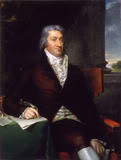
Image: Robert R. Livingston Jr.
Chancellor of New York
by John Vanderlyn, ca. 1804
By 1791, Livingston had become a Jeffersonian Republican, in uncomfortable alliance with his old foe Governor Clinton and the energetic newcomer Aaron Burr. At odds with the Jays, Schuylers, Van Rensselaers, and other traditional friends, Livingston began a decade of sometimes lonely, often acrimonious opposition to the Federalists. He fought against Jay’s Treaty and maintained strong Francophile sentiments.
The Jeffersonian Republican Party – better known as the Democratic-Republican Party – evolved in the 1790s, during the early days of George Washington’s presidency. Jefferson and his followers favored states’ rights and a strict interpretation of the Constitution. They believed that a powerful central government posed a threat to individual liberties. They viewed the United States more as a confederation of sovereign entities woven together by a common interest. In 1798, Robert Livingston Jr. ran for Governor of New York on the Democratic-Republican ticket, but was defeated by Governor John Jay, who was re-elected.
Chancellor Livingston concluded his public career as Thomas Jefferson’s Minister to France between 1801 and 1804. On his arrival in France, he was received by Napoleon Bonaparte, then First Consul, with marked respect and cordiality. Livingston and James Monroe, who had recently joined him in Paris, negotiated the Louisiana Purchase, which was signed May 2, 1803. The final deal was $15 million for approximately 828,000 square miles, only pennies an acre. Overnight, the size of the United States doubled. It was the triumph of Livingston’s career.
While he was in France, the Chancellor also entered into a partnership with Robert Fulton, a Pennsylvania-born inventor who shared Livingston’s fascination with steam navigation. Their steamboat, the Clermont, embarked on its maiden voyage between New York City and Albany in 1807, stopping briefly at Clermont Manor, and continued up the Hudson River to Albany – completing in just under 60 hours a journey which had previously taken nearly a week by sloop.
Livingston resigned his diplomatic post in 1804. After touring Europe, he returned to his home in Clermont, and retired from politics. He had a keen interest in farming, and maintained an active correspondence with Jefferson, Washington, and others regarding the latest scientific agricultural methods. Before his death, he also founded and became the first president of the American Academy of Fine Arts and became a trustee of the New York Society Library.
Robert R. Livingston died at Clermont on the Hudson February 26, 1813, at the age of 66. He was buried in the old manor Livingston family vault at Clermont.
Mary Stevens Livingston died in 1814.
SOURCES
Robert R. Livingston
Robert Livingston (1746–1813)
Chancellor Robert R. Livingston, Jr. and Mary Stevens
